
Duart Castle, or Caisteal Dhubhairt in Scottish Gaelic, is a castle on the Isle of Mull, beside the Sound of Mull off the west coast of Scotland, within the council area of Argyll and Bute. The castle dates back to the 13th century and is the seat of Clan MacLean. One source states that the castle was "brought back from ruin in 1911". The regimental colours of the WW1 Canadian Expeditionary Force 236th Battalion, CEF are laid up in the Great Hall.

Clan Maclean is a Highlands Scottish clan. They are one of the oldest clans in the Highlands and owned large tracts of land in Argyll as well as the Inner Hebrides. Many early MacLeans became famous for their honour, strength and courage in battle. They were involved in clan skirmishes with the Mackinnons, Camerons, MacDonalds and Campbells, as well as all of the Jacobite risings.
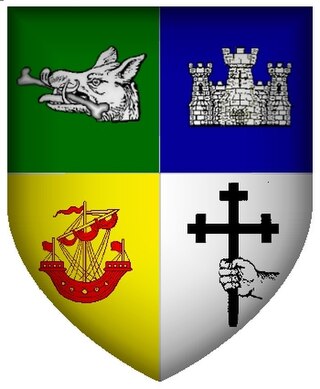
Clan MacKinnon is a Highland Scottish clan from the islands of Mull and Skye, in the Inner Hebrides.
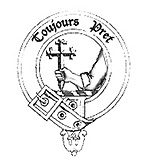
Clan MacDonald of Dunnyveg, also known as Clan Donald South, Clan Iain Mor, Clan MacDonald of Islay and Kintyre, MacDonalds of the Glens (Antrim) and sometimes referred to as MacDonnells, is a Scottish clan and a branch of Clan Donald. The founder of the MacDonalds of Dunnyveg is Eòin Mòr Tànaiste Mac Dhòmhnaill, a son of Iain Mic Dhòmhnaill and Margaret Stewart of Scotland, daughter of King Robert II. Members of the clan actually pronounced and spelled their name M'Connall due to the Gaelic pronunciation of the name Mac Domhnuill thus giving rise to the surname McConnell and its variants. While historically recognised as a clan by the Court of the Lord Lyon, it is now an armigerous clan as it no longer has a chief. The last chief was Sir James MacDonald, 9th of the Clan MacDonald of Dunnyveg or Clan Donald South, who died in London in 1626.

There have been two baronetcies created for persons with the surname Maclean, one in the Baronetage of Nova Scotia and one in the Baronetage of the United Kingdom. Both creations are extant as of 2010.
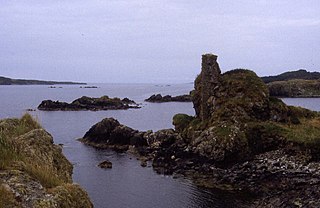
Dunyvaig Castle, is located on the south side of Islay, in Argyll, Scotland, on the shore of Lagavulin Bay, 4 kilometres from Port Ellen. The castle was once a naval base of the Lord of the Isles, chiefs of Clan Donald. It was held by the chiefs of the Clan MacDonald of Dunnyveg.
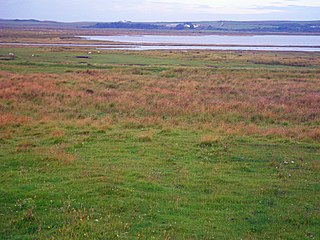
Loch Gruinart is a sea loch on the northern coast of isle of Islay in Scotland. Land at the head of the loch, Gruinart Flats, is a designated nature reserve owned by the RSPB. It is an important winter roosting site for barnacle geese. Ardnave Point is a coastal promontory near the mouth of the loch on the northwest of Islay.

The Battle of Traigh Ghruinneart or in Scottish Gaelic Blàr Tràigh Ghruineart or sometimes called the Battle of Gruinart Strand was a Scottish clan battle fought on 5 August 1598, on the Isle of Islay, in the Hebrides. It was fought between the Clan Donald and Clan Maclean. A tràigh or stand is the flat area of land bordering a body of water, a beach, or shoreline.

The Battle of the Western Isles was a series of conflicts in 1585 and 1586 on the islands of Jura, Islay, Mull and Tiree, Scotland as well as the peninsula of Kintyre on the mainland. However, although the historic sources describe this as having taken place in the "Western Isles" which are now known as the Outer Hebrides, all of the aforementioned locations are actually in the Inner Hebrides. It was fought between the Clan Macdonald of Sleat and Clan MacDonald of Dunnyveg against the Clan Maclean. In 1585, the Macleans slaughtered a party of the MacDonalds of Sleat when they were mistakenly accused of stealing cattle and the MacDonalds of Sleat and Dunnyveg retaliated. James VI of Scotland intervened but the conflicts continued into 1586. After further intervention an act of Parliament was passed which would levy fines on any clan chiefs who did not maintain peace and good order among their vassals.

Sir Hector Og Maclean (1583–1623), or Eachann Óg Maclean in Scottish Gaelic, was the 15th Clan Chief of Clan Maclean in Scotland.
Lachlan Bronnach MacLean, was the 7th Chief of Clan MacLean.
Lachlan Lùbanach Maclean, 5th Chief was Chief of Clan Maclean. He was the first Maclean to occupy Castle Duart as the 1st Laird of Duart. His brother, Hector Reaganach Maclean was the progenitor of the Lochbuie Macleans usually MacLaines.
Lachlan Catanach Maclean was the 11th Clan Chief of Clan MacLean from 1515 until his murder in 1523.

Sir Lachlan Mór Maclean or Big Lachlan Maclean, was the 14th Clan Chief of Clan MacLean from late 1573 or early 1574 until 1598. Mór or Mor translates as big in English, or magnus in Latin, when added to a name in Scottish Gaelic.
Goraidh Mac Eachann MacAlasdair was born c. 1570-1580s, he became 5th of Loup, Chief of Clan MacAlister in 1587. He died in c. 1636 at Tarbert, Argyll, Scotland.

Loch Gorm Castle is a ruined castle located on Eilean Mòr on Loch Gorm, Islay, Scotland. It was once a stronghold of Clan Macdonald.
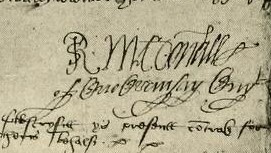
Sir James MacDonald, 9th of Dunnyveg, was the last chief of Clan MacDonald of Dunnyveg or Clan Donald South. He was most often known as James M'Connall from the Gaelic pronunciation of the name Mac Dhòmhnaill, the modern Macdonald spelling being the anglicization of the name.
Angus MacDonald, 8th of Dunnyveg was the Chief of Clan MacDonald of Dunnyveg.
Mulindry House, also known as Caisteal Mhic Dhomhnuill or Mullintrae House, was a fortified house north of Mulindry Farm, Islay, Scotland.
Sir Lachlan Mackinnon was chief of the Scottish Highland clan Mackinnon and played a prominent part in the troubled and transitional politics of the West Highlands in the early 17th century.













